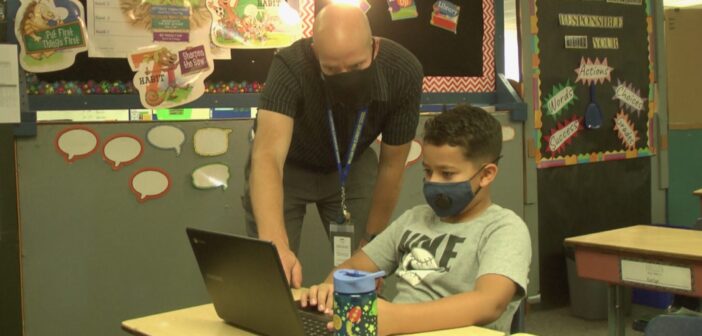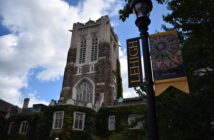COVID-19 has impacted education around the globe, forcing schools, teachers, students and families to adapt to a type of instruction unfamiliar to them — online learning. Lehigh Valley public schools are no exception.
The onset of COVID-19, and the need to retool how education is delivered, has had many negative consequences. One of the most profound is the digital equity gap the pandemic has exposed.
For online learning to work smoothly, students need access to a laptop and high-speed internet. Yet, according to school district administrators in Allentown, Parkland and Bethlehem, large numbers of students in the area have neither a device nor access to broadband.
But the absence of these resources is not experienced evenly. That’s because median family income in each of these school districts varies widely, as does the revenue each district gets from school taxes and state funding.
The Allentown School District has the lowest median family income in the Lehigh Valley, while Parkland has one of the highest, and Bethlehem falls in the middle. Despite these disparities, district administrators said they have been working tirelessly to close the digital equity gap. All have prioritized what they call a 1:1 initiative, where every single student with need is issued a school device and provided a Wi-Fi hotspot or access to low-cost Wi-Fi.
Each district was able to achieve this by tapping federal funding from the Coronavirus Aid, Relief and Economic Security Act, also known as the CARES Act, but Allentown and Bethlehem, which are larger and have a higher number of low-income families, also had to rely on local grants and donations to meet the 1:1 target.
The extent of each district’s digital equity gap correlates with the socioeconomic status of families in the districts and, in some towns, poverty has highlighted struggles that may have previously flown under the radar.
In Bethlehem, some “families find themselves having to choose between paying for food or their cable bill,” said Mark James, the Bethlehem Area School District’s supervisor of professional learning and technology integration.
According to lehighvalleylive.com, of the 17 school districts in the Lehigh Valley, Allentown has the lowest median family income at $36,807, Parkland has the second-highest at $82,336, and Bethlehem lands around the middle at $57,162. The difference in the amount of money each district has to spend in comparison to its student population across the three districts is stark: Allentown, with more than 16,000 students, has around $5 million to spend on education; Parkland, with around 9,000 students, has about $14 million; and Bethlehem, with about 13,000 students, has approximately $12 million said Jacqueline Palaochko, a reporter for The Morning Call.
Although the wealth disparities between these districts affect the size of their digital equity gap, each district assessed the problem similarly. They all produced surveys to gather information on the digital equity gap in their respective districts, as well as having families fill out direct request forms listing their needs. Each school district then distributed Chromebooks or Kajeet hot spots—a Wi-Fi hot spot with a filter to prevent from accessing non-school related information—based on those needs.
Lucretia Brown, ASD’s deputy superintendent of equity, accountability and school improvement, said Allentown has fulfilled every request for a device or Wi-Fi hot spot thus far.
“The goal and the strategy is to keep our finger on the pulse of the need and to make sure that our families have an opening and the mechanism to communicate with us,” said Brown. “We communicate out and they communicate in because the need shifts—they might not have a need one month and have it the next.”
Parkland conducts annual surveys on the digital equity gap, said Tracy Smith, PSD’s assistant to the superintendent. Over recent years, the percentage of families with need has stayed consistent at around 3 percent.
To close the gap, Parkland started their 1-1 initiative three years ago. Called Parkland Ready 21, the program has issued a device for every K-12 student for the 2020-2021 school year, Smith said. Devices are distributed on a request-by-request basis, she explained.
“We have given out over 150 [Kajeet units] or we’ve referred families to everyoneon.org, which allows families who qualify to get internet for as low as $10 a month,” Smith said.
James said he had also been working on a 1-1 initiative before COVID-19 hit and had distributed devices to all high schoolers and eighth-graders with need. When schools shut down, the district shipped devices home to students in grades six and seven and offered devices to all families that needed one. This fall, the district issued Chromebooks to all students in grades K-12.
In the fall of 2019, Bethlehem had purchased 100 Kajeet units. The district bought another 100 when COVID-19 hit. By the end of the school year, they had given out 187 units. This past summer, the district purchased 500 T-Mobile hot spots that have the filter and unlimited data.
James said Friday afternoons are his busiest— if he gets requests for hot spots or devices, he doesn’t wait until Monday to fulfill them because that would mean an entire weekend would pass before a student has the ability to do schoolwork.
All three districts relied on the CARES Act to fund these purchases. However, while this funding was more than enough in Parkland, it wasn’t adequate for Allentown and Bethlehem to close the digital equity gap—they also had to turn to state grants and local donations.
Parkland was able to use this funding to buy Kajeet units, as well as online content for the teachers, said Smith.
To close the gap in Allentown, the Allentown School District Foundation and Century Fund provided money to support the purchase of 1,000 Wi-Fi hot spots, according to a press release on the ASD’s website. A grant from the Pennsylvania Department of Community and Economic Development helped purchase 3,517 more.
James said that Northampton County announced a grant program to provide $100,000 to BASD to help pay for home internet for residents in the district.
He described COVID-19 as a “blessing hidden in a curse,” as the pandemic helped Bethlehem close the digital divide.
“COVID-19 kind of poured Miracle-Gro on our efforts to close that connectivity gap…This year, there’s every reason to believe that every child in our school district of 13,000 students has access to the internet,” James said.
But these districts didn’t stop with just closing the digital equity gap. Each also provided additional resources for families ranging from information guides on their websites to live tech support to help with technological issues families face.






Comment policy
Comments posted to The Brown and White website are reviewed by a moderator before being approved. Incendiary speech or harassing language, including comments targeted at individuals, may be deemed unacceptable and not published. Spam and other soliciting will also be declined.
The Brown and White also reserves the right to not publish entirely anonymous comments.